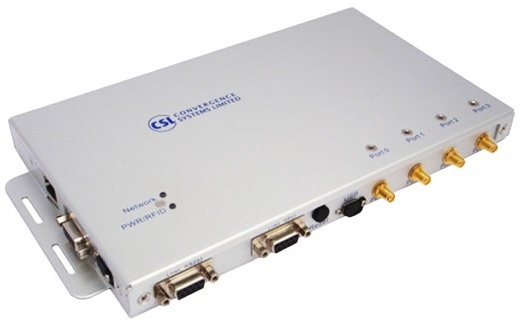CS469 4-Port Reader connecting up to 4 antennas is an Ethernet POE connected UHF EPC C1 G2 RFID reader with long read range (12 meters with Dogbone tags from Smartrac) and high read rate (300 tags per second). The high performance level, combined with affordable price, makes the CS469 the best total cost solution in the industry. With the same API as CS203 and CS468 – CSL Unified API, the application development time and cost are reduced, resulting in a faster
CS469 4-Port Reader connecting up to 4 antennas is an Ethernet POE connected UHF EPC C1 G2 RFID reader with long read range (12 meters with Dogbone tags from Smartrac) and high read rate (300 tags per second).
The high performance level, combined with affordable price, makes the CS469 the best total cost solution in the industry. With the same API as CS203 and CS468 – CSL Unified API, the application development time and cost are reduced, resulting in a faster time to market.
Features:
• Best Price/Performance Ratio
• 4-ports for connecting up to 4 antennas
• Long read range of 12 meters depending on tag
• High read rate: 300 tags/second
• Dense Reader Mode (DRM) available
• Ethernet connectivity, with PoE+ (IEEE802.3at)
• CSL Unified API – Same API as that of CS203, CS468 and CS101 readers
Specifications:
Physical Characteristics: Length: 272 mm; Width: 153 mm; Height: 25 mm
Weight: 0.7 Kg
Read Range: CS469-2 with CS771S-2 antenna (FCC version): 12 meters with DogBone tags from Smartrac
Read Rate: 300 tags/second
Protocol: ISO18000-6C, EPC UHF Class 1 Gen 2, Dense Reader Mode available (Class 3 Gen 2 compliant)
Frequency Range: One of the following: 865-868 MHz, 865-867 MHz, 902-928 MHz, 922-928 MHz, 920-925 MHz, 915-922MHz
Output Power: 30 dBm at RF connector
RF Connectors: Reverse Polarity SMA Jack
External Control: 2 x GPO and 2 x GPI
Environment: Operating Temp: -20°C to 50°C (-4°F to 122°F)
Storage Temp: -40°C to 85°C (-40°F to 185°F)
Humidity: 95% Non-condensing
Usage: Indoor use only, NEMA enclosure box is required for protection in outdoor environment
Connectivity: Ethernet (POE+), USB, Serial (RS232)
Power Supply: DC supply (12 V, 2.5 A), or use PoE+ (IEEE802.3at)
Order Code for Frequency Regulations:
CS469-N
N=1: 865-868 MHz (Europe) & 865-867 MHz (India)
N=2: 902-928 MHz, USA, Canada & Mexico only (hopping frequencies locked)
N=2 AS: for 920-926 MHz, Australia only (hopping frequencies locked)
N=2 NZ: for 921.5-928 MHz, New Zealand only (hopping frequencies locked)
N=2 OFCA: for 920-925 MHz, Hong Kong only (hopping frequencies locked)
N=2 RW: for 902-928 MHz, Rest of the World that are subset of this band: e.g. Philippine, Brazil, Peru, Uruguay, etc.
N=4: 922-928 MHz, Taiwan
N=7: 920-925 MHz, China, Malaysia, Singapore, Thailand, etc.
N=8: 916.7-920.9 MHz, Japan
N=9: 915-921 MHz, Europe Upper Band
RFID Basics
Passive tag RFID technology involves the reader, the antenna and the tag.
The reader sends out energy in the relevant frequency band to the antenna via RF cables, and the antenna radiates the energy out. This energy impinges on an RFID tag.
The RFID tag consists of an antenna coupled to an RFID IC. This IC converts the AC voltage it receives at the antenna port to DC voltage that in turn is used to empower the digital circuit inside.
The digital circuit then turns on and off some components connected to the antenna port, thereby changing its scattering behavior, in a pre-designed clock rate.
This changing of antenna port parameters then causes a “modulation” of the back-scattered RF energy.
This modulated back-scattered energy is detected by the reader and the modulation is captured and analyzed.


